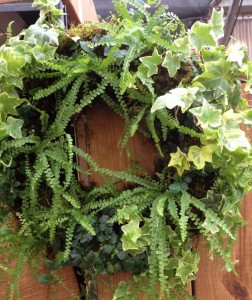
A living wreath planted for shade using houseplant ferns, creeping fig and ivy…
This post is for all you do-it-yourselfers and those that just like to know how interesting plantings are created. Living wreaths are one of those things, or, as I like to think of them, the original vertical garden arrangement. Maybe you’ve seen them on Pinterest or at your favorite garden shop (Of course, if you’re in Birmingham, we hope that’s us!).
Living wreaths are not difficult to make and are really quite fun – it just takes some time and a little thought choosing plants. The first step is deciding where you’d like to have your living wreath. Perhaps you have a gate leading into your garden? Or maybe there’s a blank spot on that shady patio wall? They also work well placed on a flat surface such as a table.
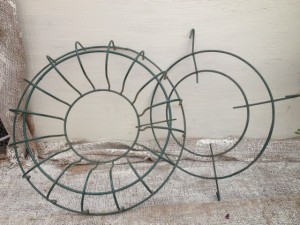
The sturdy wreath form you see here is a standard plastic coated 16″ size. You can see there are two pieces, and the smaller back piece hooks easily onto the larger one.
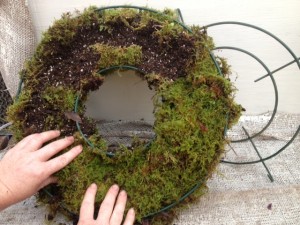
Lining the form prior to planting…
Many how-tos for living wreaths use moistened sphagnum moss to line the form. We plant them a bit differently, lining the form with moistened green sheet moss, then filling the cavity with potting soil and slow release fertilizer before planting. We’ve been planting hayracks, moss baskets and wreaths like this for over 20 years in this manner.
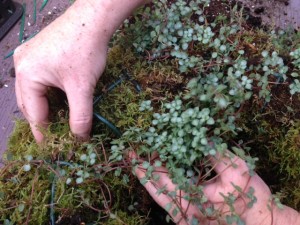
insert plants at intervals through the moss, firming in.
Jamie designed the wreath in this demonstration for a customer who wanted an interesting mix of foliage for use in a bright location. Her plant material includes pilea, tillandsias, tiny pink cryptanthus, and baby tears. It’s important to understand the cultural needs of the plants being used so any special watering needs can be met. In this composition, the baby tears will need special attention as they require the most water.
As with any open wired container that is being lined, don’t skimp on the moss. It’s the glue that’s holding everything together after all. When the form is thickly lined, add the potting soil, moistening it and firming it in, then add a slow release fertilizer like Osmocote. Remember to always use a good quality soilless mix when planting any type of container. After the cavity is filled, add more sheet moss to the “back” of the wreath and attach the smaller piece. Now your wreath form is ready to plant!
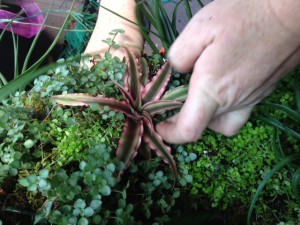
Adding the cryptanthus…
Water your plants well, then insert them into the wreath by pushing a hole into the moss with your fingers so the soilless mix is exposed. Of course, the smaller the plant the easier this step will be. Once the plant is firmed into place add more sheet moss if needed to keep the soil around the root ball of the plant.
Some plants can be purchased in larger pots and pulled apart, like the pilea and baby tears shown here. It may look a little messy at first, but they will recover in no time. Many plants that work well in living wreaths can be separated in this manner, including ivy, creeping fig, fittonia, asparagus fern, creeping jenny, dwarf mondo, some small ferns and many succulents.
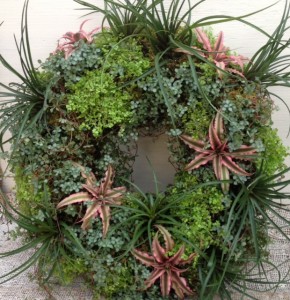
Finished!
What makes these wreaths so interesting and fun to make is the use of different foliage colors, textures and shapes. But, in addition to foliage, wreaths like those shown here can also be planted with bedding plants – in the spring begonias work well and, in the fall, violas and pansys make lovely wreaths too.
Watering requirements will vary on living wreaths, depending on the plants used. For instance, a wreath planted with succulents will need less attention than those shown here.

a living wreath for shade with fittonia, creeping fig and pilea
We’ve found the easiest watering method is to lay them flat and either pour water on them or let them sit in a saucer of water until the planting is heavy. The ivy, fern and creeping fig wreath shown at the beginning of this post lived in the greenhouse, so we were able to shower it with the hose when it needed watering, and the ivy and creeping fig was periodically pinned to the wreath with florist wire so it could root into the moss.
So, as you can see, it just takes time, the proper plants and the right technique to make a living wreath – try one for yourself!

 Now that January is behind us, we can look forward to spring, knowing it is right around the corner. Until then, we’ve been satisfying our planting urges using late winter offerings from growers. We are determined to come up with something interesting on long winter days in the greenhouse!
Now that January is behind us, we can look forward to spring, knowing it is right around the corner. Until then, we’ve been satisfying our planting urges using late winter offerings from growers. We are determined to come up with something interesting on long winter days in the greenhouse!

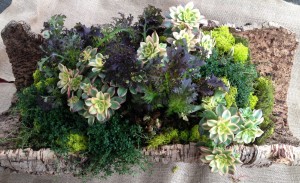 Many of the succulent aeoniums fare better here during the winter months. They seem to dislike our excessive summer humidity (Don’t we all?), and the Aeonium ‘Kiwi’ seemed just right to work into some sort of arrangement. I loved how they looked paired with this frilly dark purple leaf ornamental mustard. If I could just work it into a container that could be moved in and out easily if temperatures dropped below freezing…
Many of the succulent aeoniums fare better here during the winter months. They seem to dislike our excessive summer humidity (Don’t we all?), and the Aeonium ‘Kiwi’ seemed just right to work into some sort of arrangement. I loved how they looked paired with this frilly dark purple leaf ornamental mustard. If I could just work it into a container that could be moved in and out easily if temperatures dropped below freezing…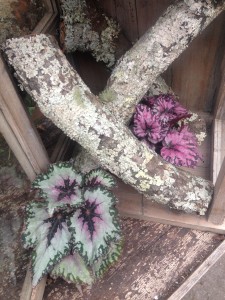


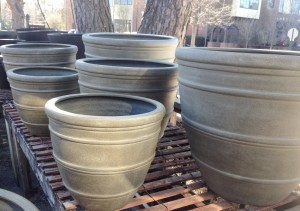
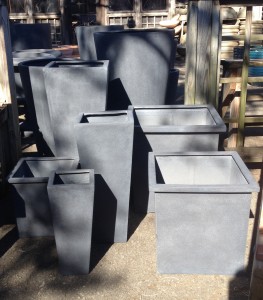
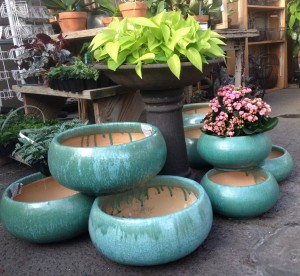

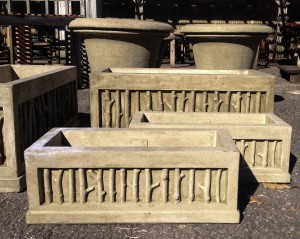

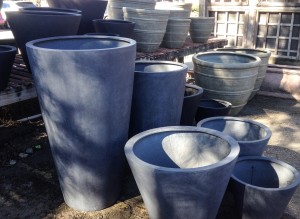
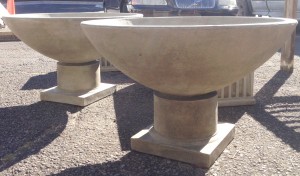
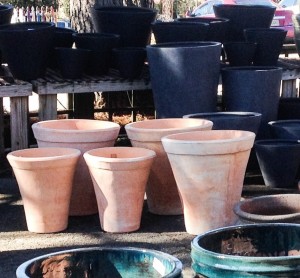
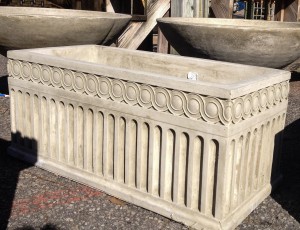
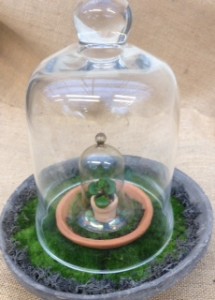 If you haven’t noticed,
If you haven’t noticed, 





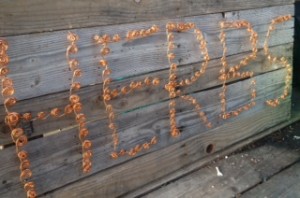
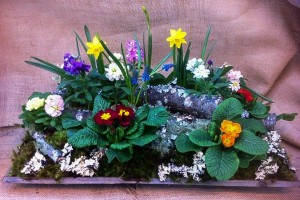
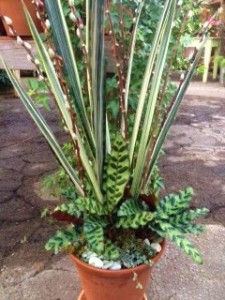
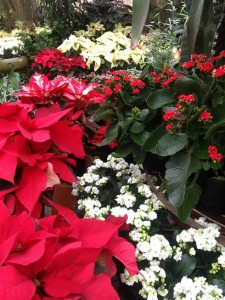 The greenhouse is so beautiful all year round, but it’s especially so in the height of the holiday season. In fact, sometimes there are so many flowers and new plants coming in almost daily that they are literally everywhere – on tables, on the floor around tables, and anywhere we can find a spare space. Never let it be said we don’t have a little something for everyone!
The greenhouse is so beautiful all year round, but it’s especially so in the height of the holiday season. In fact, sometimes there are so many flowers and new plants coming in almost daily that they are literally everywhere – on tables, on the floor around tables, and anywhere we can find a spare space. Never let it be said we don’t have a little something for everyone!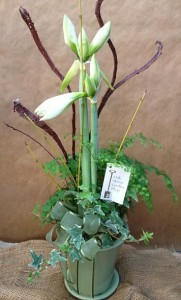
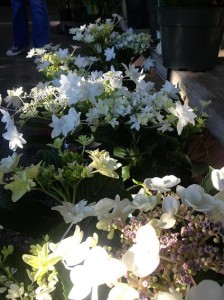
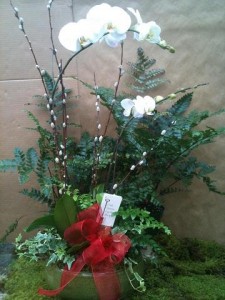
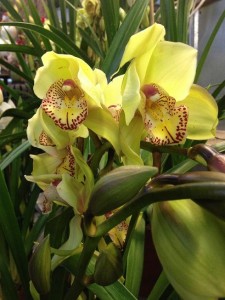

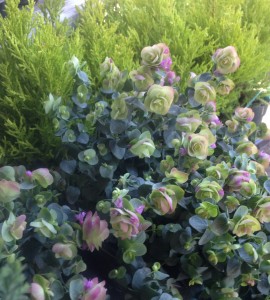
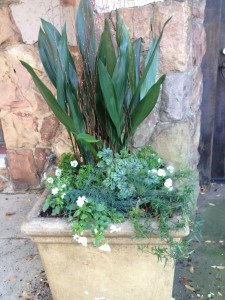
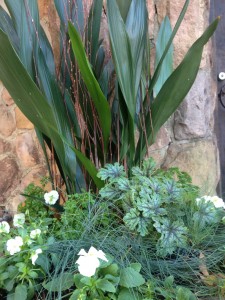 The emphasis is on foliage, though, and I’ve included curly parsley for it’s fresh green color, a small blue fescue grass, and a shade loving heuchera for this planting. Holdovers from the summer are aspidistra, which I thin out each season, and a tiny leaf green ivy. After planting, I added birch branches to add more height and winter interest. (Branches are an easy way to get color in planters during the holiday – red twig dogwood branches would also be pretty.) While it looks a bit top heavy with the tall aspidistra at first, the parsley and heuchera will add fullness to the composition as it grows in. I’m also trying the Cool Wave white trailing pansies here this year, hoping they get enough sun to bloom well.
The emphasis is on foliage, though, and I’ve included curly parsley for it’s fresh green color, a small blue fescue grass, and a shade loving heuchera for this planting. Holdovers from the summer are aspidistra, which I thin out each season, and a tiny leaf green ivy. After planting, I added birch branches to add more height and winter interest. (Branches are an easy way to get color in planters during the holiday – red twig dogwood branches would also be pretty.) While it looks a bit top heavy with the tall aspidistra at first, the parsley and heuchera will add fullness to the composition as it grows in. I’m also trying the Cool Wave white trailing pansies here this year, hoping they get enough sun to bloom well.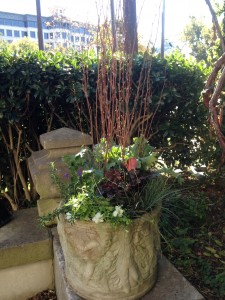
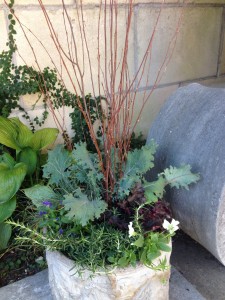 This fall Pardis asked if I would also take a look at the planters at Bottega, their other wonderful restaurant.
This fall Pardis asked if I would also take a look at the planters at Bottega, their other wonderful restaurant.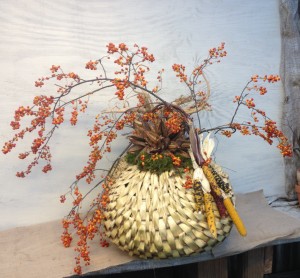 Autumn inspires us! The past month we’ve been designing with thoughts of fall…a copper container, a beautiful basket, a heavy stone trough, and even something as simple as a wooden box made wonderful starting pieces for a few of them.
Autumn inspires us! The past month we’ve been designing with thoughts of fall…a copper container, a beautiful basket, a heavy stone trough, and even something as simple as a wooden box made wonderful starting pieces for a few of them.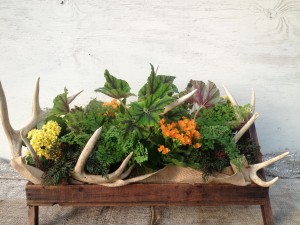 This wooden box arrangement was done for a garden club – the customer brought in the antlers! This one was a fun change of pace. Those antlers didn’t want to stay put, and the box was a tad rickety…it reminds us that each day may bring different and interesting challenges!
This wooden box arrangement was done for a garden club – the customer brought in the antlers! This one was a fun change of pace. Those antlers didn’t want to stay put, and the box was a tad rickety…it reminds us that each day may bring different and interesting challenges!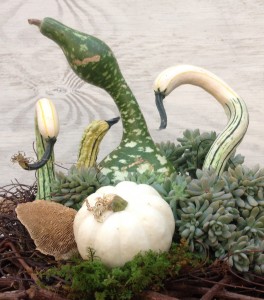
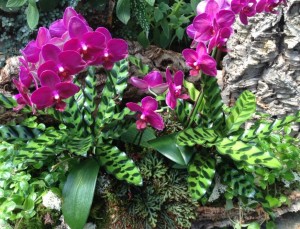 This summer’s wet, cool weather might have kept many of you out of your gardens, but we’ve managed to stay busy in the greenhouse putting together arrangements filled with orchids, succulents, houseplants, and so much more…here’s a peek at some of them. We regularly have folks who stop in just to see what we’ve been working on! All of these arrangements are composed of live plants, no cut flowers here.
This summer’s wet, cool weather might have kept many of you out of your gardens, but we’ve managed to stay busy in the greenhouse putting together arrangements filled with orchids, succulents, houseplants, and so much more…here’s a peek at some of them. We regularly have folks who stop in just to see what we’ve been working on! All of these arrangements are composed of live plants, no cut flowers here.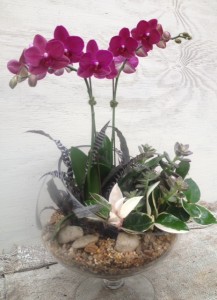
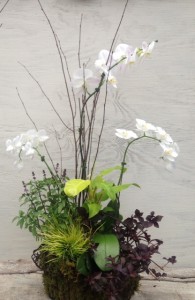
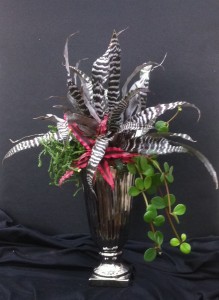 Finally, the silver container was given in memory of someone…the longlasting and low maintenance houseplants of trailiing pepperomia and cryptanthus make excellent companions. It’s gratifying, also, to know that whoever is on the receiving end will be able to enjoy this longer than a fresh flower arrangement could ever hope to last.
Finally, the silver container was given in memory of someone…the longlasting and low maintenance houseplants of trailiing pepperomia and cryptanthus make excellent companions. It’s gratifying, also, to know that whoever is on the receiving end will be able to enjoy this longer than a fresh flower arrangement could ever hope to last.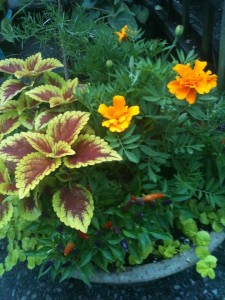 I’m not quite sure I’ve been living in the Southeast this summer…plentiful rain and decent temperatures – (Though it looks like the heat is finally returning.) this has been Alabama in August?!
I’m not quite sure I’ve been living in the Southeast this summer…plentiful rain and decent temperatures – (Though it looks like the heat is finally returning.) this has been Alabama in August?!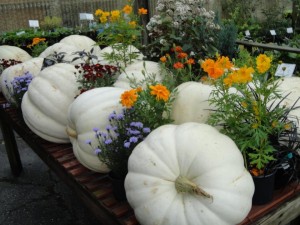
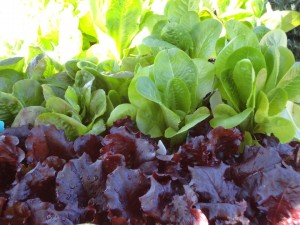 But, if your garden and beds are struggling…think about where you’d like to see marigolds, ornamental peppers, late season salvias, and, further down the road, lettuce, asters and cool season herbs – we’ll have transplants of parsley, thyme (Look for the lemon variegated thyme which looks beautiful with green or red lettuce and marigolds.) dill and cilantro too.
But, if your garden and beds are struggling…think about where you’d like to see marigolds, ornamental peppers, late season salvias, and, further down the road, lettuce, asters and cool season herbs – we’ll have transplants of parsley, thyme (Look for the lemon variegated thyme which looks beautiful with green or red lettuce and marigolds.) dill and cilantro too.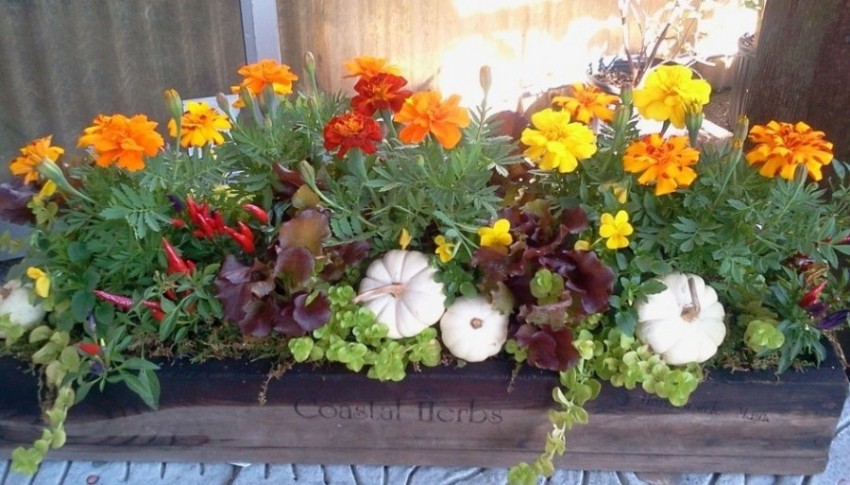
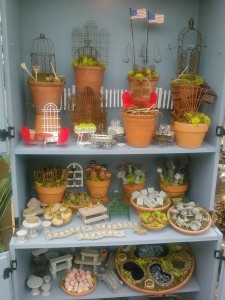 For all of you
For all of you 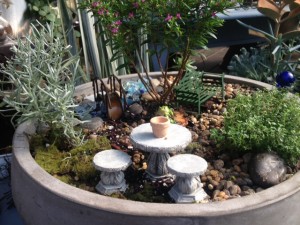
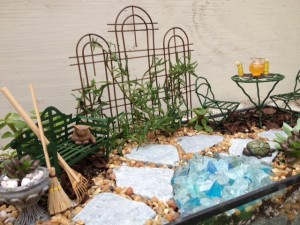 Some people have asked why we don’t carry fairies and other inhabitants for our miniature gardens. For us, the garden is the key – creating a miniature garden world with plants that actually will grow for you…along with some judicious clipping when needed. (Fairies are there in spirit, not seen, and, if the garden has the magic of the creator’s touch, of course they’ll come.)
Some people have asked why we don’t carry fairies and other inhabitants for our miniature gardens. For us, the garden is the key – creating a miniature garden world with plants that actually will grow for you…along with some judicious clipping when needed. (Fairies are there in spirit, not seen, and, if the garden has the magic of the creator’s touch, of course they’ll come.)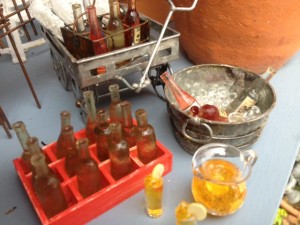 These miniature gardens have really struck a chord for adults and kids alike, and it’s so much fun to see the delight by adults and excitement of little ones as they browse (and play with) the tiny creations that can be used in their own gardens. Of course, any activity that stimulates imagination is certainly worthwhile! For children, it’s a make believe world; for adults it’s an outlet to grow plants in a different way.
These miniature gardens have really struck a chord for adults and kids alike, and it’s so much fun to see the delight by adults and excitement of little ones as they browse (and play with) the tiny creations that can be used in their own gardens. Of course, any activity that stimulates imagination is certainly worthwhile! For children, it’s a make believe world; for adults it’s an outlet to grow plants in a different way.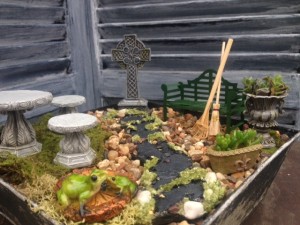 All was well until the night the little girl had a sleepover party with a couple of her friends…you might well imagine where this story is going! Somehow the miniature garden, which she kept in her bedroom, was completely up-ended in the middle of the bed, an utter mishmash of soil, plants,pea gravel, stones and little accessories. It must have been like Humpty Dumpty falling off the wall in the fairytale! We helped rework the little miniature garden, and hopefully that little girl is still happily raking her pea gravel “path”…
All was well until the night the little girl had a sleepover party with a couple of her friends…you might well imagine where this story is going! Somehow the miniature garden, which she kept in her bedroom, was completely up-ended in the middle of the bed, an utter mishmash of soil, plants,pea gravel, stones and little accessories. It must have been like Humpty Dumpty falling off the wall in the fairytale! We helped rework the little miniature garden, and hopefully that little girl is still happily raking her pea gravel “path”…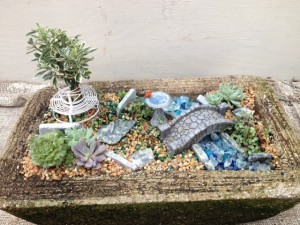 Not long ago a parent, her daughter, and the girl’s little brother came in. The mother marched to the counter with the little boy and said that he needed to buy, with his own money, a stone for his sister’s miniature garden. Puzzled, I asked what kind of stone he needed. Well, the mother said, her daughter had a stone with the words “My Garden” written on it in her miniature garden. Evidently the little boy had turned it around and scrawled “bathroom” on the back! Of course, the boy’s sister wasn’t having any of that in her garden. So, we found the perfect stone, wrote “My Garden” on it for the little girl, and the little boy brought out his money to pay for it. Before they left, the mother gave the little boy the stone that he’d written on. Much later we found it hidden in the miniature garden displays and had a good laugh….he didn’t want it either!
Not long ago a parent, her daughter, and the girl’s little brother came in. The mother marched to the counter with the little boy and said that he needed to buy, with his own money, a stone for his sister’s miniature garden. Puzzled, I asked what kind of stone he needed. Well, the mother said, her daughter had a stone with the words “My Garden” written on it in her miniature garden. Evidently the little boy had turned it around and scrawled “bathroom” on the back! Of course, the boy’s sister wasn’t having any of that in her garden. So, we found the perfect stone, wrote “My Garden” on it for the little girl, and the little boy brought out his money to pay for it. Before they left, the mother gave the little boy the stone that he’d written on. Much later we found it hidden in the miniature garden displays and had a good laugh….he didn’t want it either!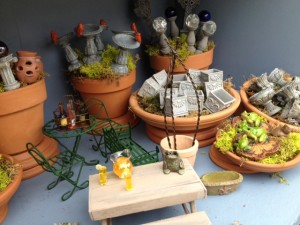 Some of the fun things we’ve gotten in recently include a pair of ghosts (It’s never too early to begin thinking about Halloween!), wooden soda bottle crates with soda bottles, a wine basket with wine bottles, a metal tub (just right to put the wine and soda bottles in!), tiny turtles, frogs and one very fat cat, some pretty urns, a very realistic Celtic cross, a stone walking bridge, a triple trellis and more. And there will be additional miniature garden items coming in down the road too. It’s a good idea to pop in every now and then to see what’s new.
Some of the fun things we’ve gotten in recently include a pair of ghosts (It’s never too early to begin thinking about Halloween!), wooden soda bottle crates with soda bottles, a wine basket with wine bottles, a metal tub (just right to put the wine and soda bottles in!), tiny turtles, frogs and one very fat cat, some pretty urns, a very realistic Celtic cross, a stone walking bridge, a triple trellis and more. And there will be additional miniature garden items coming in down the road too. It’s a good idea to pop in every now and then to see what’s new.






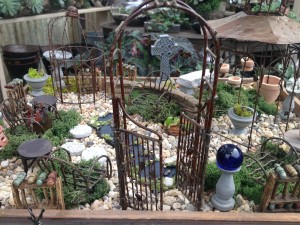
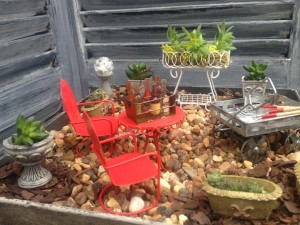
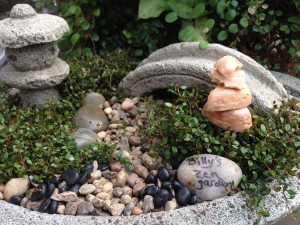
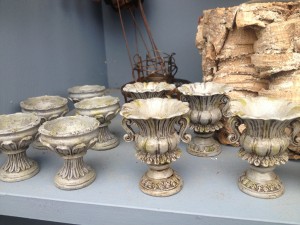
 If you’d like to have us put one together for you we have containers here, or you can bring something of your own in and we’ll create one for you. All we ask is that you give us ample time to put your miniature garden together – they may look less time consuming to make than a full size garden, but we promise you the devil is in all those minature details!
If you’d like to have us put one together for you we have containers here, or you can bring something of your own in and we’ll create one for you. All we ask is that you give us ample time to put your miniature garden together – they may look less time consuming to make than a full size garden, but we promise you the devil is in all those minature details!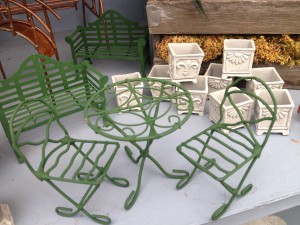 Some plants that can be used for gardens that will be used outside are many low growing sedums, echevarias, hen and chicks, euonymous standards (They make great trees!), tiny bromeliads, air plants and miniature jade plants to name just a few…indoor gardens (or
Some plants that can be used for gardens that will be used outside are many low growing sedums, echevarias, hen and chicks, euonymous standards (They make great trees!), tiny bromeliads, air plants and miniature jade plants to name just a few…indoor gardens (or  Ok, this might not be the moss hanging basket for your front porch…in fact, its proportions are massive, at least 30″ across and almost as deep. This basket belongs to a customer who hangs it in in a shady garden area.
Ok, this might not be the moss hanging basket for your front porch…in fact, its proportions are massive, at least 30″ across and almost as deep. This basket belongs to a customer who hangs it in in a shady garden area.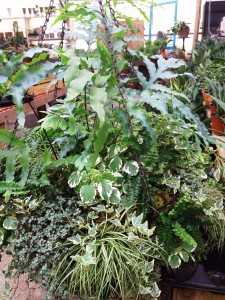 This year, she wanted an all white and green foliage basket filled top to bottom with shade loving plants. What a fun project! The basket itself is a heavy duty plastic coated metal frame with openings that plants can be inserted into. Many folks use sphagnum moss or coco liner for these type of plantings, and it works well. However I prefer to use fresh green sheet moss and layer the plantings from the bottom up.
This year, she wanted an all white and green foliage basket filled top to bottom with shade loving plants. What a fun project! The basket itself is a heavy duty plastic coated metal frame with openings that plants can be inserted into. Many folks use sphagnum moss or coco liner for these type of plantings, and it works well. However I prefer to use fresh green sheet moss and layer the plantings from the bottom up.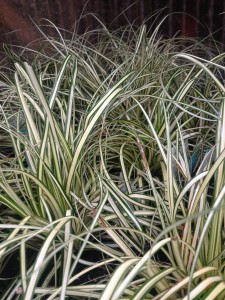
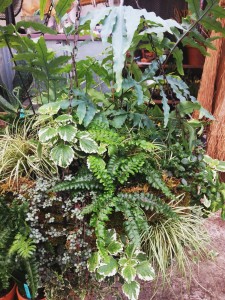
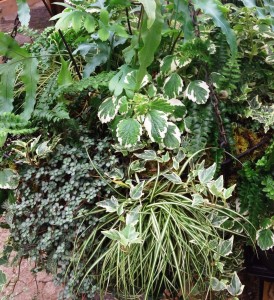
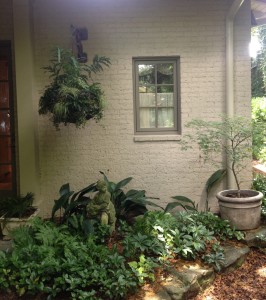
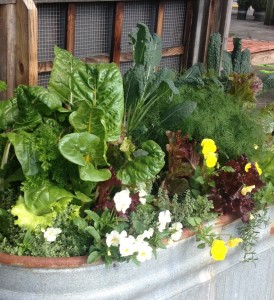


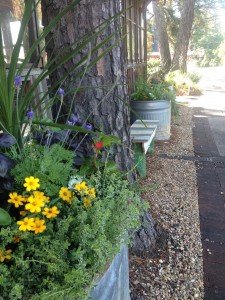
 Owners Frank and Pardis Stitt prefer white and green for the front of this French cafe, located next to their acclaimed restaurant Highlands in downtown Birmingham. These are fairly large, tan colored cast stone planters with nice clean lines. A mix of contrasting green and variegated foliage with a touch of white add light to this shady spot, and the stone wall adds a pleasing backdrop to the planting.
Owners Frank and Pardis Stitt prefer white and green for the front of this French cafe, located next to their acclaimed restaurant Highlands in downtown Birmingham. These are fairly large, tan colored cast stone planters with nice clean lines. A mix of contrasting green and variegated foliage with a touch of white add light to this shady spot, and the stone wall adds a pleasing backdrop to the planting.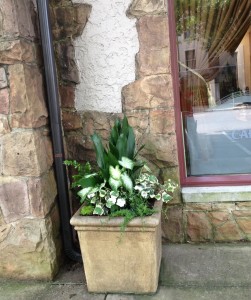


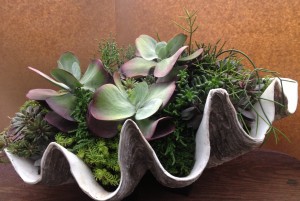 WOW! A customer brought this in the other day and I was the lucky one that got to plant it up! This clam shell is the real deal…a beautiful, large piece of natural art that had found its way to us.
WOW! A customer brought this in the other day and I was the lucky one that got to plant it up! This clam shell is the real deal…a beautiful, large piece of natural art that had found its way to us.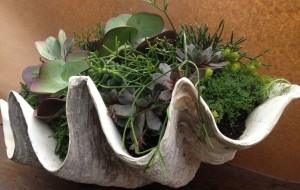
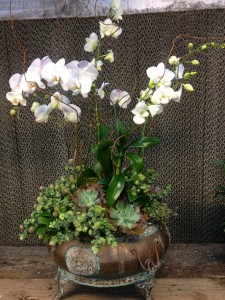

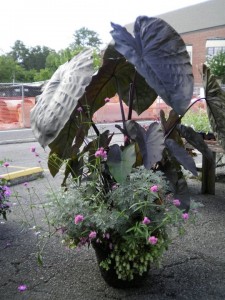
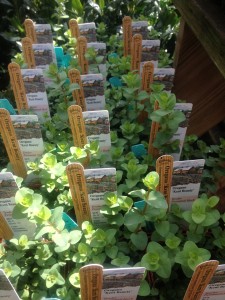
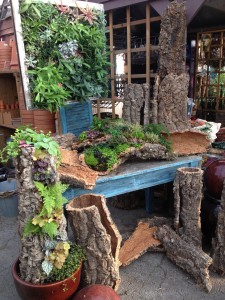
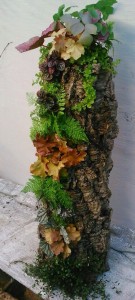
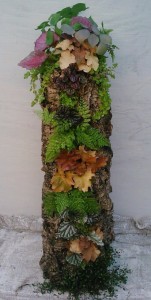 The tall one that Jamie planted utilizes houseplants which work very well in shaded areas through the summer, and some perennials. This piece will take filtered sun and clipping of the houseplants to maintain the balance of the planting. A pot was inserted in the bottom, planted, and then soil filled to the top, filling the opening all the way up to create a cool vertical piece.
The tall one that Jamie planted utilizes houseplants which work very well in shaded areas through the summer, and some perennials. This piece will take filtered sun and clipping of the houseplants to maintain the balance of the planting. A pot was inserted in the bottom, planted, and then soil filled to the top, filling the opening all the way up to create a cool vertical piece.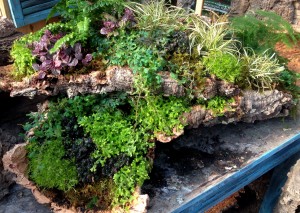 In the next planting, I took 3 of the flatter, rounded pieces and actually “stacked” them at angles, creating planting pockets and different levels and an overall shape I was pleased with. Next, perennials, including tassel ferns, ‘Metallica’ and ‘Burgundy Glow’ ajuga, golden and peacock selaginellas, Scotch moss and Carex ‘Evergold’, were added, creating sweeps of color and wispy trailers over the edges. An added bonus is that all of these plants are perennial and can be used in your landscape as they outgrow the container.
In the next planting, I took 3 of the flatter, rounded pieces and actually “stacked” them at angles, creating planting pockets and different levels and an overall shape I was pleased with. Next, perennials, including tassel ferns, ‘Metallica’ and ‘Burgundy Glow’ ajuga, golden and peacock selaginellas, Scotch moss and Carex ‘Evergold’, were added, creating sweeps of color and wispy trailers over the edges. An added bonus is that all of these plants are perennial and can be used in your landscape as they outgrow the container.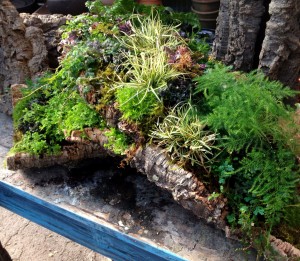 Both of these have been lined before planting but will drain over the edges in the case of the stacked pieces and down through the bottom of the planting in the tall piece. We picture them in areas of restful shade, adding their green presence to woodland surroundings…We hope you enjoy our creations as much as we enjoyed making them!
Both of these have been lined before planting but will drain over the edges in the case of the stacked pieces and down through the bottom of the planting in the tall piece. We picture them in areas of restful shade, adding their green presence to woodland surroundings…We hope you enjoy our creations as much as we enjoyed making them!